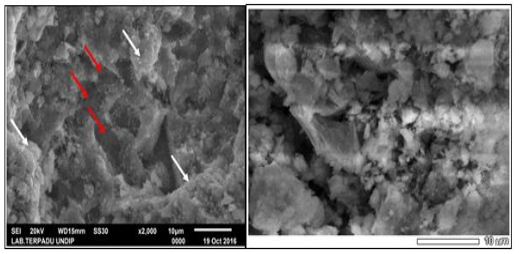An Experimental Study on Effect of Palm – Shell Waste Additive to Cement Strenght Enhancement
DOI:
https://doi.org/10.24273/jgeet.2017.2.1.33Keywords:
Nanosilica, Nanocomposite, Compressive Strength, Shearbond Strength, CementingAbstract
Enhancing the cement strength through attaching chemical additive has been popular to meet the required condition for a particular well-cementing job. However, due to a low oil-price phenomenon, pouring and additive should be reconsidered because it can raise the cost and make the project become uneconomic. Another additive material in nanocomposite form will be introduced through this experimental study. The nanocomposite material consist of silica nanoparticle, known as “Nanosilica” and a palm-shell-waste, which is abundant in Indonesia. Before making a nanocomposite, the palm-shell should be burned to obtain a charcoal form, ground and sieved to attain a uniform size.
The study focuses on the two parameters, compressive strength and shear bond strength, which can reflect the strength of the cement. These values are obtained by performing a biaxial loading test to the cement sample. Various samples with different concentration of nanocomposite should be prepared and following the mixing, drying, and hardening process before the loading test is carried out. The result from the test shows a positive indication for compressive strength and shear bond strength values, according to the representative well cementing standards. Increasing the nanocomposite concentration on the cement will increase these values. Furthermore, an investigation on the temperature effect confirms that the sample with 700oC burning temperature have highest compressive-strength and shear-bond-strength values. This is a potential opportunity utilizing a waste-based material to produce another product with higher economic value.
Downloads
References
Bae, W.S., 2016. UTILIZATION OF NANOSILICA-PALM SHELL NANOCOMPOSITE TO ENHANCE CEMENT STRENGTH IN WELL CEMENTING 58–61.
Dirjenbun, 2015. Kelapa sawit. Tree Crop Estate Stat. Indones. 2014-2016 79pp.
Ershadi, V., Ebadi, T., Rabani, A., Ershadi, L., Soltanian, H., 2011. The Effect of Nanosilica on Cement Matrix Permeability in Oil Well to Decrease the Pollution of Receptive Environment. Int. J. Enviromental Sci. Dev. 2, 128–132.
Falode, O.A., Salam, K.K., Arinkoola, A.O., Ajagbe, B.M., 2013. Prediction of compressive strength of oil field class G cement slurry using factorial design. J. Pet. Explor. Prod. Technol. 3, 297–302. doi:10.1007/s13202-013-0071-0
Hadiguna, S.C., 2016. Laboratory Study: Effect of Temperature on Palm Oil Shell Carbon to Increase Strength Drilling Cement 2016.
Haryanti A., Norsamsi,Sholiha P.S.F., P.N.P., 2014. Studi Pemanfaatan Limbah Padat Kelapa Sawit. Konversi 3.
Institut, A.P., 2002. API 10A/ISO 10426-1-2001 Effective Specification for Cements and Materials for Well Cementing 49.
Novriansyah, A., Rita, N., Husbani, A., 2015. Effect of Nanosilica Injection to Oil Recovery Factor in Low Porosity and Permeability Reservoir 9, 11–13.
Palmer, C., 1990. Edited by. Critique 42000. doi:10.1016/B978-0-444-53858-1.00028-4
Rubiandini, R., Siregar, S., Suhascaryo, N., Efrial, D., 2005. The Effect of CaO and MgO as Expanding Additives to Improve Cement Isolation Strength under HPHT Exposure. ITB J. Eng. Sci. 37, 29–47. doi:10.5614/itbj.eng.sci.2005.37.1.3
Siregar, E., n.d. Studi Laboratorium : Pemanfaatan Limbah Abu Sekam Padi dan Arang Cangkang Kelapa Sawit Sebagai Light Weight Additive Untuk Meningkatkan Strength Semen Pemboran Program Studi Teknik Perminyakan , Fakultas Teknik , Universitas Islam Riau.
Worathanakul, P., Payubnop, W., Muangpet, A., 2009. Characterization for Post-treatment Effect of Bagasse Ash for Silica Extraction 3, 339–341.

Downloads
Published
Issue
Section
License
Copyright @2019. This is an open-access article distributed under the terms of the Creative Commons Attribution-ShareAlike 4.0 International License which permits unrestricted use, distribution, and reproduction in any medium. Copyrights of all materials published in JGEET are freely available without charge to users or / institution. Users are allowed to read, download, copy, distribute, search, or link to full-text articles in this journal without asking by giving appropriate credit, provide a link to the license, and indicate if changes were made. All of the remix, transform, or build upon the material must distribute the contributions under the same license as the original.










